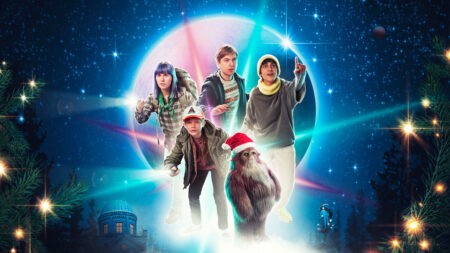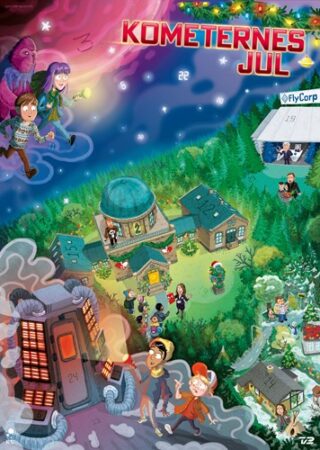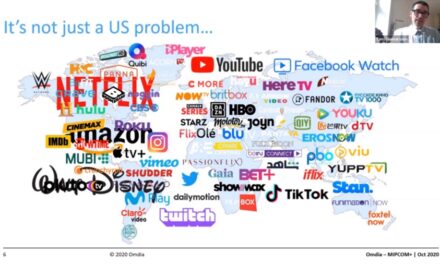Children’s content is often linked to ideas of certain learning outcomes. This is obvious in much factional content for children marked by ‘edutainment’ agendas, but also in the realm of fiction, particularly fiction targeting the youngest viewers. Ambitions that fiction should be more than ‘just entertainment’ also marks certain public service broadcasting cultures, for instance at the Danish Broadcasting Corporation DR where a concept such as ‘double storytelling’ has been an integral part of the production framework, referring to how good public service fiction should contain social and/or ethical layers besides having an entertaining and engaging story (Redvall 2016).

Fig. 1: With its purple-blue colour tone, Christmas of the Comets sets the scene for a sci-fi Christmas adventure into outer space. Photo credit: Christian Geisnæs/TV 2.
This December, what can be regarded as ‘double edutainment storytelling’ for both children and grownups has seen a new form in Danish television with the premiere of this year’s television Christmas calendar on the commercial public service broadcaster TV 2. The idea for the legendary 24-episode format running in primetime from December 1-24 (Agger 2013, 2020) came from the Niels Bohr Institute at the University of Copenhagen where Professor in Astrophysics and Planetary Science, Anja C. Andersen, together with producer and founder of even Production, Marie Breyen, got substantial funding to communicate facts about the natural sciences to the wider public.
They found that the best way to do this would be to create a television Christmas calendar, a format that still sees all members of a family gathered around the screen for a shared viewing experience, and one that would have the potential to generate interest in the natural sciences across generations. As Marie Breyen explained when giving a guest lecture to students at the Department of Communication at the University of Copenhagen in November, the intention behind the production, Christmas of the Comets, was to create a setting where learning about the natural sciences didn’t feel like school and would facilitate conversations about the topic around Danish dinner tables (Breyen 2021).
From ‘AstroCamp’ to Planet 9
To achieve this, Andersen and Breyen took their idea to the broadcaster TV 2. There’s ‘a gentleman’s agreement’ between DR and TV 2 which sees them taking turns to make an original television Christmas calendar (while the other broadcaster airs a rerun) so as to not compete in this quite particular and very popular format. TV 2 were to produce the original production for 2021 and was fond of the idea of the natural science element, not least with substantial grant money attached, which would finance a large transmedia universe about natural sciences around the television episodes. Nordisk Film Series came on board to produce the series for TV 2 with showrunner Jenny Lund Madsen in charge of the writing process where the writers had free reign, as long as there was at least one aspect related to natural sciences in every episode.

Fig. 2: Based on conversations with astrophysicist Anja C. Andersen, showrunner Jenny Lund Madsen created a story involving the hypothetical Planet 9 with many fascinating things to explore. Photo credit: Christian Geisnæs/TV 2
Based on conversations with Anja C. Andersen, that included fascinating debates and unknowns in astrophysics, Jenny Lund Madsen decided to create an arena, an ‘AstroCamp’, where the four 12-year-old protagonists of the story would spend time exploring the world of natural sciences. However, in the very first episode, two of them are accidentally quantum teleported to Planet 9, a hypothetical planet in the outer region of the solar system. Following this, the story unfolds with an episode a day where we follow their attempts to safely return to planet Earth, while their peers at AstroCamp try to help cover up the fact that two camp participants are in fact in outer space – with a broken quantum teleportation machine.
The AstroCamp setting naturally allows for scientific discussions and experiments (for instance what happens when a red Poinsettia, the essential Christmas plant, is dipped in liquid nitrogen) while the Planet 9 adventure provides an opportunity for a more colourful sci-fi story in outer space addressing numerous questions about the solar system and fascinating facts about quantum teleportation experiments.
The transmedia universe around the serial
This year’s television Christmas calendar thus has a somewhat surprising backstory, emerging from the Niels Bohr Institute which has a very outspoken mission to generate interest in the natural sciences. The series is also the first time that an extensive transmedia universe, ‘Universet Udenom’ (the Universe Around) accompanies a Christmas calendar through several different initiatives and productions on a variety of platforms.
The television Christmas calendar is always accompanied by a printed cardboard calendar where each door contains something linked to the episode of the day. This year each door is an AR code which provides access to extra material intended to stimulate curiosity in the natural sciences or to make the viewer a little wiser about the universe. Furthermore, every day a live science show is shot in a new location in Denmark for the Christmas calendar’s YouTube channel, and there’s a lot of other accompanying material such as videos, insights, fun facts, quizzes and cartoons all of which address the natural sciences.

Fig. 3: Behind each door of the cardboard calendar is an AR code that functions as a digital gateway into extra material about natural sciences. Credits: TV 2
Following the project from the sidelines, it has been fascinating to see the amount of transmedia content being produced and the way in which the natural science element has, until now, been prominent in each episode. The big December question then is: how do Danish families respond to the Christmas calendar and do they in fact engage with the many different entry points in ‘Universet Udenom’, the universe around the television production?

Fig. 4: ‘Universet Udenom’ presents many different kinds of material about natural sciences, leading into the ScienceYear22. Photo credit: Screenshot from videnskabsår22.dk
The plan to focus on natural sciences in the month of December will lead into a national ‘ScienceYear22’, which was also initiated by the Niels Bohr Institute to partly celebrate the centenary of the award of the Nobel Prize for Physics in 1922 to Niels Bohr, as well as the foundation of the Niels Bohr Institute in 2021. In this way, Christmas of the Comets is also intended as a gateway to upcoming science encounters and celebrations, some of which are already accessible on the official ‘ScienceYear22’ website.
Viewing figures and future perspectives
Following the first episode – the most watched programme on Danish TV in the week of its premiere with 866.000 viewers on December 1st (Nygaard 2021) – Christmas of the Comets sparked great curiosity not only amongst the broad Danish family audience but also critics. Overall, the production received positive reviews in the press, accompanied by the recurring annual criticism of whether new Christmas calendars have enough Christmas specific elements, such as elves. This year, some also expressed concerns that the story would turn into tiresome lectures on physics (Rasmussen 2021).
Even though linear viewing numbers decreased remarkably during December, Katrine Vogelsang, Head of Fiction at TV 2, has stated that TV 2 is satisfied with the series’ performance. She emphasizes that, when adding the views on TV 2’s streaming platform, the numbers are satisfactory, not the least for a Christmas calendar venturing into completely new territory rather than building on existing material or well-known characters (in Nygaard 2021).
From the perspective of the Reaching Young Audiences research project, there are several interesting aspects in Christmas of the Comets as a case breaking new ground, both with regard to its unique origin story and the collaboration between research funds and institutions, a private production company and a commercial public service broadcaster, and with regard to its take on the television Christmas calendar genre and the transmedia universe around it.
It will be interesting to see where it all ends on December 24 and to follow the evaluations of whether this will be perceived as a conducive way to co-fund and create new content for children and families in the coming years. As for the story, in line with the long-running tradition of Danish television Christmas calendars, we do expect that everyone will return safely from Planet 9 and celebrate a proper Christmas on planet Earth. So far, the serial is only available in Danish and on Danish screens so you will have to take our word for it.
Katrine Bouschinger Christensen is PhD fellow in the Section of Film Studies and Creative Media Industries at the University of Copenhagen with a thesis on producing serial drama and online fiction for children and young audiences as part of the RYA research project. https://comm.ku.dk/staff/?pure=en/persons/394276
Eva Novrup Redvall is Associate Professor at the University of Copenhagen where she is head of the Section for Film Studies and Creative Media Industries and principal investigator of the RYA research project. https://comm.ku.dk/staff/?pure=en%2Fpersons%2Feva-novrup-redvall(fc809983-e37f-4f44-b71a-a0b1d36295b9).html
References:
Agger, Gunhild. 2013. ‘Danish TV Christmas calendars: Folklore, myth and cultural history’. Journal of Scandinavian cinema, 3 (3), 267–280. https://doi.org/10.1386/jsca.3.3.267_1
Agger, Gunhild. 2020. ’The Magic of The Danish Christmas Calendar’. Cstonline.net. December 18, 2020. https:///the-magic-of-the-danish-christmas-calendar-by-gunhild-agger/
Breyen, Marie. 2021. Guest lecture at the Niels Bohr Institute for students from the Department of Communication at the University of Copenhagen, 23 November, 2021.
Hansen, Kjartan. 2021. ’Kometernes jul’. Ekko.dk. November 30, 2021. https://ekkofilm.dk/anmeldelser/kometernes-jul/
Nygaard, Kristian Dam. 2021. ’Seerne falder fra TV 2s nye julekalender: Dårligste start i flere år’. BT.dk. December 8, 2021. https://bt.dk/film-tv-og-streaming/seerne-falder-fra-tv-2s-nye-julekalender-daarligste-start-i-flere-aar
Rasmussen, Anita Brask. 2021. ’Glædelig 1. december, unger, så er der ekstra fysiktimer i fjernsynet!’. Information.dk. December 1st, 2021. https://information.dk/kultur/anmeldelse/2021/11/glaedelig-1-december-unger-saa-ekstra-fysiktimer-fjernsynet
Redvall, Eva Novrup. 2016. ‘The concept of ‘double storytelling’ in Danish public service TV drama production.’ In S. Maras (ed.): Ethics in Screenwriting: New Perspectives. Basingstoke: Palgrave Macmillan: 33–54. https://doi.org/10.1057/978-1-137-54493-3_2






Many, many thanks for this to Karine and Eva – what a brilliant and fascinating piece to end the year with. Bless you. I have to say that I’d never come across this form of programming until Gunhild’s piece last year, and it was lovely to be reminded of this… while also kind of wishing that this sort of thing had been around when I was still of an age to form the target audience.
Hoping that you’re warm and safe and hoping to spend the holidays with those dearest to you.
Glædelig Jul! 🙂
Andrew
Nice to hear that this is of interest outside of Scandinavia, Andrew. We also learned a lot from reading your piece this week. So many different traditions and strategies across different television cultures in Europe. It’s great that we have this space to share writings on this and learn from each other.
A glædelig jul and a godt nytår to you too! In colour and everything 🙂
Eva and Katrine
Oh… bless you both.
Take care and have fun! 🙂
Andrew